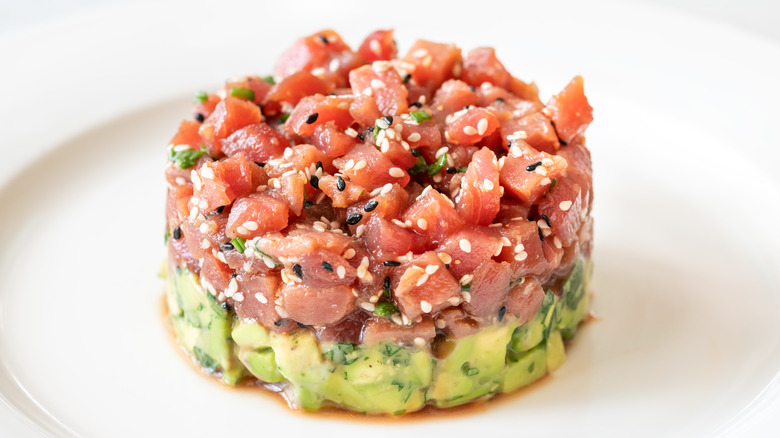Tuna Isn't The Only Fish You Can Serve Tartare
There is something about "tartare" that just feels ... fancy. You might commonly see beef and tuna tartare on upscale restaurant menus. Tuna tartare is a way to highlight the flavor and texture of freshly caught tuna. The fish is usually cut into small cubes or pieces, then paired with different elements that enhance the dish — anything from ginger, avocado, and soy sauce to sesame oil, and various herbs are paired with the tuna. The tartare is usually served after being shaped in a ring to create a more attractive presentation. However, tuna isn't the only fish that makes for a mouth-watering flavor in this dish.
Other fish, such as salmon or cod, also make delicious tartare. While the fish is the main difference, other ingredients are also used in these dishes to better pair with the main element. Although there are risks to consuming raw fish, when properly prepared and retrieved from a reputable fishmonger, there is little risk to consuming fish tartare-style.
Try making tartare with a different type of fish
While tuna is the most common fish served in tartare, it's not the only option. Salmon is another popular fish around the world, and salmon tartare is a great alternative if fresh tuna isn't available. Salmon has a stronger, somewhat fishier flavor than tuna, so you'll need different ingredients to complement it. Lemon juice enhances almost any fish, but hot sauce and capers are other great complements to salmon. Tartare dishes often incorporate acidity, so additions like vinegar and mustard help balance the salmon's flavor. Salmon is widely used in sushi, so to give the dish a similar flair, you can make a tartare with ingredients like fresh ginger and sesame oil. Add some finely diced jalapeño for texture, and use lime zest for acidity.
Cod, on the other hand, has an extremely mild flavor; it's a great place to start if you've never had tartare before. You can enhance it with almost anything you want, giving it a sweet, spicy, or savory twist. Fresh fruits like grapefruit or oranges will add a sweet, acidic touch, but you can use mango for less acidity, too. To vary the texture, chopped bell peppers are a great addition.
Is it safe to eat fish tartare?
Consuming any raw or undercooked meat or fish carries a risk of food poisoning. If you're pregnant or immunocompromised, you should never consume raw fish. Raw fish can harbor bacteria and parasites, and while perfectly healthy people might be able to fight off an infection, this isn't the case for everyone.
A major factor in lowering the risk of foodborne illness is the quality of the fish. Only purchase raw fish from a reliable fishmonger who you're certain uses the best possible hygiene practices. According to the FDA, freezing the fish for several days can kill certain parasites, making it even safer to consume. Store the fish at minus 4 degrees Fahrenheit or lower for seven days before using it to create an even safer tartare.
The risk is low for contracting an illness from eating raw fish, but also understand that adding acid elements to your tartare dish will not kill infectious parasites, according to The Food Safety Information Council. Still, if you purchase reliably caught and stored fish, and especially if you freeze it before use, you run little risk of getting sick.


